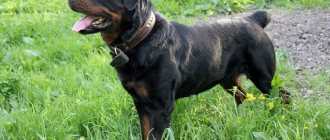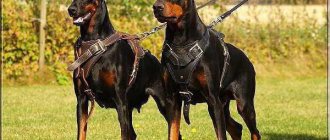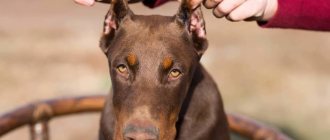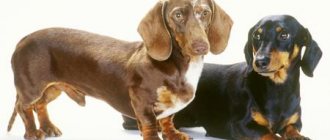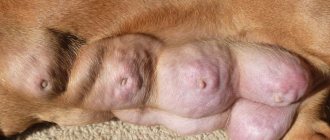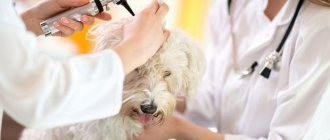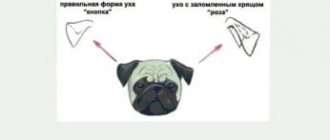The Miniature Pinscher is a dog breed that previously had its tails and ears docked in accordance with international standards. Later, this standard was changed, since docking was banned in many European countries. There is no official ban in Russia yet, but more and more opponents of the operation are emerging, since it causes pain to the animal.
In Russia, cases of docking miniature pinschers for decorative purposes persist
Why dock ears and tail?
The Miniature Pinscher breed was bred to protect houses and stables. To give the dog a frightening appearance, docking was carried out. Her ears were cropped to give them an aggressive, pointed shape. In a natural position, the ears will be pressed tightly to the temples.
Thanks to cropping, it is easier to care for the ears and reduces the risk of increased injuries during fights with other dogs. The tail was docked for the same purpose, to protect the dog. The tail of this breed is long; during a fight, the enemy could cause significant harm.
Attention! Since 1987, more than 10 developed countries have completely banned cupping. This was achieved by animal activists and simply animal lovers.
This procedure is reserved only for service and guard dogs; for others it is considered cruel and unnecessary. Russia has not yet joined this ban.
Caring for undocked ears
A miniature pinscher's undocked ears should not lie on his cheeks. They need to be raised in the cartilage area with a “rose” or “envelope”. This can be done at home.
- Clean your ears.
- Make a fold out of soft fabrics.
- Secure the ears in this position with adhesive tape.
- Make sure that the pinscher does not remove it with his paw.
- Change the sticker until your ear gets used to it.
The healthier the cartilage, the faster the ears will find their correct position. Therefore, provide your pet with a healthy diet and regularly give a complex of vitamins.
The younger the miniature pinscher is, the cheaper the docking operation will be. For puppies in the first month of life, the tail can be trimmed for 1000 rubles, and the ears for 300-500 rubles. When a veterinarian comes to your home with instruments, the price increases by 1000 rubles.
Docking an adult dog costs more. This operation is performed under anesthesia, and after the procedure it is necessary to give the pet painkillers. In addition, the risk of complications increases, since the cartilage of the tail is already completely ossified. The veterinarian sets the price after examining the pinscher. Usually it is 4000-5000 rubles.
Cropping miniature pinscher ears lost its practical purpose when dogs were no longer used as guards and escorts.
Now the breed is widespread as a companion dog, so the decision to shape the ears is of a cosmetic nature.
A correctly chosen shape emphasizes the grace of the lines of the head, giving completeness to the appearance.
But as breeders note, the demand for undocked representatives of the miniature pinscher breed is increasing: people are increasingly purchasing puppies with natural characteristics.
Having decided to shape your dog’s ears, you need to take into account a number of rules in order to accurately prepare him for surgery and the subsequent rehabilitation period.
Purpose of the operation
Today, dogs of this breed are no longer used as guards, therefore, docking is no longer done for practical purposes. The operation is performed only for aesthetic reasons. Thanks to it you can give the dog elegance.
The Russian breed standard continues to support both docking and natural appearance. Without surgery, the dog's ears will be turned towards the temples, the inner edges will fit tightly to the cheekbones. They can be erect or hanging on cartilage. After cropping, the ears will definitely be erect.
Miniature Pinscher without cropped ears
Ear cropping
If the operation is performed under anesthesia, it is possible to dock the tail and ears of a miniature pinscher at the same time. For puppies, circumcision should be carried out at intervals of 2-3 days. The procedure involves placing a stencil on the ear and cutting off excess skin. Templates are:
At the last stage, the doctor applies sutures without touching the cartilage. Session time is 25-30 minutes.
The advantage of cupping in the clinic is compliance with sterile conditions. The office has tools and medications to provide first aid in case of complications. Home surgery also has advantages. The dog does not have to experience the additional stress of moving. Puppies can calm down next to their mother within a few minutes after being trimmed.
The benefits and harms of the operation
For practical purposes, it is not necessary to crop a Miniature Pinscher's ears. Many animal rights activists oppose this operation, considering it abuse of the dog. There are a number of positive and negative aspects of the procedure.
The benefits of cupping include the following:
- A miniature pinscher with undocked ears requires special care. He often develops inflammation, and the shells are difficult to care for.
- A docked tail is difficult to break or damage during games and fights with other dogs.
Opponents of the procedure highlight several negative nuances:
- The docked miniature pinscher is unemotional and has poor contact with other animals.
- Tail trimming leads to impaired motor skills.
Important ! But the most important argument is that docking causes dogs severe pain and the need to endure a difficult rehabilitation stage.
Maintenance and care
The miniature pinscher can be kept both in an apartment and in a private house where there is a walking area. The pet must be protected from drafts and cold. The sleeping area should be secluded so that the dog can rest peacefully.
- Wool: brushing 2-3 times/week. Occasionally wipe the dog with a special mitten or a damp towel to remove dead hairs. Washing - as needed, using special shampoos containing protein.
- Ears: regularly wipe with a damp soft cloth. Movements must be careful.
- Eyes: examination, removal of discharge with a cotton swab moistened with water.
- Teeth: weekly brushing will prevent the formation of tartar.
- Nails: trim as needed. If walks are frequent and long, the claws wear off on their own.
The puppy is adopted at the age of 2-3 months. It is not advisable to adopt an adult dog, since its character has already been formed, and besides, changing the owner is a lot of stress. The place of detention should be bright and clean. An indicator of a puppy’s health is curiosity, showing interest in unfamiliar people and objects.
A small miniature pinscher should have certain exterior features:
- The correct bite is a scissor bite, the canines are closed in a lock. There are 6 incisors in the upper and lower jaws.
- The length of the muzzle is approximately equal to the length of the skull.
- The lines of the back of the nose and forehead should be parallel.
- The angles of the hind limbs are well expressed.
- The front legs stand straight, parallel to each other.
- The topline falls smoothly from the withers to the base of the tail.
- Back without deflection.
- There are no white spots on the coat.
- The skin pigment is painted over (nose, lips, paw pads, claws should be black).
- Black and tan individuals have a more intense tan, the boundaries of which should not be blurred.
- The red color should be more saturated.
The description of the Miniature Pinscher breed indicates the following disadvantages:
- too light frame;
- round shaped head;
- sharp stop from forehead to muzzle;
- round or large eyes;
- high feet.
Please note that the puppy cannot be picked up by the scruff of the neck or front paws. To avoid damaging the tendons, carry your pet with both hands, one lifting it under the chest and stomach, the other under the hind legs.
We suggest you read: Toxoplasmosis in cats: how an animal becomes infected, is it transmitted to humans, symptoms, analysis, treatment and vaccination
Maintenance, care
Find a separate place for the puppy, protected from drafts. The kitchen needs a separate corner for feeding; place bowls there. Buy care items:
- collar;
- leash or harness;
- carrying;
- clothes and shoes for walking in the cold season;
- soft massage brush or rubber brush;
- terry towels;
- shampoo;
- nail clipper;
- cotton swabs, ear cleaners.
You will need various toys, including squeaking, wind-up, interactive, and also those made of molded rubber. The Pinscher loves to play, but you can’t give him more than 3 items at once, as he quickly loses interest in them.
A first aid kit is required in the house. It includes:
- adhesive plaster;
- cotton wool;
- bandages simple (4 cm) and elastic (7 cm);
- hydrogen peroxide;
- chlorhexidine;
- synthomycin emulsion;
- antidiarrheal agent (suitable for children);
- anthelmintic;
- tourniquet to stop bleeding;
- pipette;
- enema bulb;
- tweezers;
- syringes (2, 5 and 10 ml);
- pharmaceutical camomile;
- Vaseline oil;
- ointment "Levomekol";
- adsorbent (activated carbon);
- potassium permanganate;
- antiallergic agent.
How to position the ears
Ear cropping for a miniature pinscher is optional; it is done to give it a unique shape. This will make the dog look more elegant. The procedure is carried out at the age of 4 months. before the teeth change. After the operation, the ears are sealed with adhesive tape, and a protective bandage is needed on the head. After a day it needs to be removed.
Treat wounds with Vitaon ointment for a week. On days 10-14, the stitches disappear. Residues can be removed using sharp scissors. During the entire wound healing period, the puppy should wear a protective collar.
The ears are placed as follows. You will need: adhesive plaster, cotton swabs, lighter fluid. Procedure:
- Cut 2 small pieces of adhesive the size of a cotton swab.
- Place a cotton swab on the sticky surface of 1 piece.
- Cover with the second piece so that the sticky part is on top.
- Degrease the inside of the ear with the prepared liquid.
- Draw out the ear and stick the structure.
- Wrap a narrow strip of plaster around each ear at the base, first separately, and then both at once (“figure eight”).
Leave for 3 days. After a day, build the structure again. The process of setting up the ears takes 1-2 weeks, sometimes several months.
It is better to walk a miniature pinscher on a harness, as it is more difficult to get out of it. This equipment is easy to use and the dog does not feel any discomfort. To train to use the toilet outside, you need to walk your puppy at least 5-6 times a day. Choose special fenced areas and other places that are safe for walking.
In public places, in the presence of other dogs, the Pinscher must be kept on a leash. Gradually increase the duration of your walks. Active games are necessary, this will avoid obesity and prevent destructive behavior.
Upbringing
Obedience must be taught from puppyhood. Under no circumstances allow your dog to break the established rules or play pranks. She will not obey if the owner shows softness or weak character.
Innate guarding and protective instincts can develop into territorial aggression, so you should not follow the dog’s lead. To ensure successful interactions with your pet, be patient and understanding. Don’t raise your voice, don’t hit the dog, at most you can spank him with a newspaper. Otherwise he will grow up angry or intimidated.
The puppy needs to be socialized. He should not be afraid of the street or show aggression towards other dogs or cats. The pinscher should not be allowed to rush at strangers who meet him during a walk.
Training
Training can begin at 4-6 months. In puppyhood, activities should be in the form of play. Start training with simple commands: “sit”, “paw”, “fetch”. Pinschers quickly remember them and can learn many tricks. The puppy should be rewarded for every task completed correctly.
In the process of training, perseverance and determination are required, but not rudeness. Small difficulties may arise: due to curiosity, the dog is often distracted, this can be confused with disobedience. Please note that the dog quickly gets bored with monotonous training, and then it stops obeying. With a pinscher you can enroll in courses: obedience, general training course, “Protective guard service”.
How many months do miniature pinscher ears crop?
Circumcision is performed at different ages. This should happen as early as possible, because small puppies tolerate surgery more easily. The tail is trimmed from the fourth to tenth day after birth. Ears can be cropped starting from the second month and ending with the third.
Adult canines have a hard time with such operations, or rather react poorly to anesthesia. The recovery period is more difficult for them. If surgery is performed on a large dog, complications may arise: a scar will appear, and the pet will develop mental illness due to the stress it has experienced.
The operation should be performed as early as possible
How is ear circumcision performed?
The operation lasts 30-60 minutes and is performed either in a clinic or at home. After the dog has been secured and all the necessary antiseptic measures have been carried out, special metal patterns are placed on the ears.
- Before applying the form, it is important to move the skin as far as possible towards the base and make marks so as not to make a mistake in the calculations for the desired size.
- The pattern is equipped with clamps that prevent severe bleeding. The operation is performed with a scalpel. If the ears are fleshy, then the blood vessels are large. This means that additional manipulation will be required to cauterize them.
- After cupping, sutures are placed on the edges of the wound. The ears are treated with antibiotics (ointments or solutions), and healing glue is often used. The cartilages are bandaged, this is necessary to form the correct posture.
You need to put a protective Elizabethan collar on your pet, which will prevent scratching, wounds, and infection.
After the operation, the puppy’s ears are tied with bandages to ensure proper formation of cartilage, which ensures beautiful posture. Not all breeds need this. Within 2-4 days after the procedure, pets are usually given analgesics, painkillers that reduce the pet’s anxiety. Wearing a collar is mandatory. You should also limit your dog's interaction with other animals to avoid injury.
We invite you to read: Detailed instructions on how to build an enclosure for a German Shepherd with your own hands
The stitches are left in place for 7-10 days. They need to be treated daily with brilliant green, peroxide, calendula infusion or streptocidal ointment. It is important to remove scabs and scabs to prevent scarring. To soften keratinized skin, use Levosin (antiseptic ointment).
Preparing the animal for surgery
The pet must be prepared for surgery in advance. It is recommended to undergo tests in advance to exclude the development of inflammatory processes. The dog owner must comply with the following rules:
- stop giving your pet food 12 hours before the upcoming surgery, limit it to water for three hours;
- if the puppy is not a newborn, then two weeks before the procedure he is given anthelmintic drugs;
- The cupping site needs to be shaved.
Important! The operation is performed only if the puppy is completely healthy.
How does the cupping procedure take place?
Miniature Pinscher docking should only be done by experienced veterinarians. At the moment, professionals offer ear cropping according to patterns using a scalpel. This procedure can be performed either in a clinic or at home. On the one hand, coming to the clinic is a good option, where sterility is guaranteed. But, in this case, the animal’s ears need to be bandaged during transportation. Surgical intervention at home also has both positive and negative sides. As they say, houses and walls heal. This rule also applies to animals. The dog will be less nervous and will be able to tolerate the procedure more calmly. In addition, you will no longer need to bandage, which promotes faster healing of wounds. But there is also a negative side. At home, no matter how hard you try, surgical sterility is difficult to provide. In emergency cases, which happen extremely rarely, the necessary drugs or equipment will not always be at hand.
So, if you decide to have surgery, first make an appointment with the veterinarian and get your dog ready. Twelve hours before the procedure, stop feeding, three hours before, stop giving water. This way the anesthesia works faster and better. After the operation itself, be sure to offer your dog some food and a drink of water. It is worth adding a painkiller to food to relieve pain after surgery. After recovery from anesthesia, the dog may vomit. Don't worry, this is a completely normal reaction of the body.
Post-operative care
A miniature pinscher with cropped ears and tail will need careful care after surgery.
The docked tail should be carefully examined morning and evening, every day, so as not to miss the onset of the inflammatory process. Be sure to treat it with an antiseptic.
Cropped ears will have to be cleaned every day with hydrogen peroxide to remove dried crusts; after softening, they are carefully removed with a cotton swab. The procedure is very important, as scars may form at the site of damage. The edges of the ears are smeared with brilliant green.
Important ! It is recommended to wear a protective collar to prevent your pet from scratching its ears. Otherwise, it may cause infection in the wound.
One day after surgery, you can remove the bandage
Rehabilitation
How long should I wait before removing the bandage? It depends on the condition of the ears. The period varies from 3 hours to a day. Immediately after the anesthesia wears off, the dog should be given a small amount of food, since the miniature pinscher will experience hunger. It is necessary to provide proper care for the ears to speed up their healing. Painkillers are mixed into the food so that the dog does not feel pain in the area of the incision lines.
For 10 days after surgery, the dog must wear a protective collar, which can be purchased at a veterinary clinic.
It is important that the length of the walls at the collar reaches the tips of the ears, otherwise the dog will itch and damage the stitches. The threads usually dissolve within 10 days. If this does not happen, you need to contact a specialist to help speed up this process. To do this, the veterinarian carefully trims the threads and removes them himself.
Putting your ears in the correct position
The placement takes place four days after the sutures are removed. There are several ways to place your ears.
The simplest of them is the use of a structure made of cotton swabs and adhesive tape. The sticks need to be treated with alcohol or any other antiseptic, the ears and the inside of the shells should be lubricated with brilliant green.
A cotton swab is glued onto a seven-centimeter piece of adhesive plaster, and the same piece of plaster is placed on top. The adhesive layer must remain on the outside. The entire structure is attached to the inside. The base of the ears must be separately covered with adhesive tape, and the tape must be connected in the shape of a figure eight. In this case, the dog’s ears are wrapped one at a time to form a stable bridge. The dressing should be changed every four days. The ears will begin to stand up between four and twelve months. The process occurs most quickly in puppies up to three months.
Is it possible to place ears without cropping?
It is not necessary that your pet’s ears will droop if surgery is not performed. There are ways to fix the ears of a miniature pinscher without cropping. The same frame is created as for dogs after surgery. The only difference will be that the bandage needs to be worn longer. At the same time, it is important to carefully examine the shells so as not to miss the inflammatory process.
A Pinscher with undocked ears will cost less than a puppy with cropped ears. This indicator plays the same role on the cost as the color of the pet.
Each owner must make a decision independently, taking into account all the nuances of the operation. The miniature pinscher is not a service dog, so docking is not required.
What is ear cropping and why is it needed?
Cupping is an operation that involves shortening the ear; in some cases the shell is removed almost completely, in others it is left long. It depends on the historically established standard and fashion for various forms.
The procedure has a long history, dating back to the times of Ancient Egypt and Rome. Dogs with cropped ears are found in images of coin impressions, frescoes, and wall paintings. The ears were cut off mainly for hunting and fighting dogs (Molossoids, Pinschers, Schnauzers and other breeds).
It was believed that such cosmetic intervention makes the dog more formidable in appearance. From a medical point of view, this cruelty is justified by the fact that a pet with cropped ears is more difficult to wound in battle. The Romans were sure that the operation was a prevention of rabies. In addition, the dog in the forest did not catch its ears, did not pick up ticks and other dangerous insects. Cropped ears are better ventilated, which prevents the stagnation of cerumen fluid and the occurrence of inflammation.
Likewise, over the centuries, standards have evolved to require cropped ears on certain breeds. Pets that do not comply with the rules were not allowed to participate in exhibitions. This developed the trend of fashion in the direction of operations for animals, which made docking a real mockery. Since the end of the 20th century, many European countries have prohibited such a measure unless it is part of treatment. This law has not yet been developed in Russia.
Now the standards have softened their conditions; pets with ears of normal length are increasingly allowed to participate in exhibitions. Dogs that no longer serve, but are purely companions, really have little need for such a procedure. Therefore, only the owner can make the decision regarding docking.
In any case, the operation must be performed within 6 months, but the owner has a choice. There are three options for performing the operation, each of them has its own advantages and disadvantages.
- Cupping of puppies up to 2 weeks old. During this period, the dog is least sensitive to physical impact, easily tolerates pain and is unlikely to remember it. In addition, tissue restoration and healing occurs much faster than in adult dogs, because the puppy is in contact with the mother and feeds on milk. But due to the incomplete formation of blood vessels, the wounds can bleed for a long time, and it is also difficult to predict the dog’s appearance, so cropped ears may look disproportionate when the pet grows up.
- 7-13 weeks of life. During this period, the puppy is not yet very susceptible to pain, but the cartilage tissue is soft, and regeneration occurs quickly. No scars remain at the site of the wounds.
- 3-6 months. The procedure is delayed due to any illness or congenital health problem. The specificity of the operation in adulthood is that the dog will need full anesthesia and suturing of the wound to avoid the appearance of dense, rough scars. It is important to ensure that your pet does not experience complications.
In veterinary medicine, it is customary to perform surgery between 14 days and 13 weeks of age. The time for cupping is selected based on individual characteristics. For example, small dogs undergo the procedure earlier than large ones. The shape of the ears also influences; complex shells are stopped at an older age.
The procedure is useful for service dogs with long ears from birth. Historically, it has been customary to trim the ears of Great Danes, Dobermans, Schnauzers, Rottweilers, Boxers, Cane Corsos, Bull Terriers, Caucasian and Central Asian Shepherds.
Nowadays, countries rarely put forward specific conditions regarding operations to improve the exterior, so only the owner can decide whether this manipulation is necessary.
We suggest you read: Keeping hedgehogs in an apartment: how long they live, what they eat, how to care for them at home
Preparing the dog
A few days before the procedure, the puppy is shown to the veterinarian to ensure that the pet is 100% healthy. The specialist will be able to determine whether the operation is permissible for a particular individual, and whether the dog has congenital abnormalities.
- The pet is prohibited from eating 12 hours before docking, although the drinking regime should not change.
- The veterinarian will give an anesthetic injection. For adult dogs - general, and for small dogs - local.
- The ears are shaved and treated with antiseptic solutions.
- The dog is fixed on the surgical table so that it lies on its side with its hind and front legs extended.
- For older animals, the jaw is secured.
It is important to calm your pet and be with him during the process. Now there is a service where a specialist comes home. The puppy’s psyche is not traumatized by moving and changing surroundings. He will feel calm and relaxed. You cannot offend or scold a child.
For each breed in need of surgery, there is its own set of forms allowed by the standard. In addition, the operation may vary depending on the size of the dog and its physical characteristics.
The Staffordshire Terrier standard specifies cropped ears, unlike the Staffbull. Which is considered strange, because the breeds are close. It is this fact that explains that, most likely, surgery for these dogs is not necessary, but is considered purely cosmetic. Owners are still confident that short ears look aesthetically pleasing and make the dog look more respectable. Since Staffs no longer participate in dog fighting, there is no point in carrying out the procedure.
The operation is performed at 1.5-3 months under general anesthesia. There are several options for the correct shape of cropped ears for this particular breed: fighting (the shortest), short, show and long. For Staffs, it is not necessary to apply forming bandages; often the ears themselves take the desired position.
The miniature pinscher is now a decorative breed, which does not interfere with long ears at all. Therefore, the operation is only cosmetic in nature. It is carried out at 3 months. Due to physiological characteristics, the ears need to be fixed. This is usually done by a veterinarian using band-aids and cotton swabs.
For Alabai, the procedure should be carried out as early as possible to avoid blood loss. Cupping is often carried out directly during childbirth. If this is not possible, then the ears are cut off before 3 days of age. For this breed, the short form is considered the only correct option. But it is also divided into several types:
- Standard (medium length with a semicircular or straight cut);
- Mishka (elongated cartilage with a semicircular cut);
- Caucasian (1.3 cartilage is the longest acceptable option).
For this breed, the procedure is carried out within a period of 3 days - 8 weeks. It is not recommended to have surgery while changing teeth. A characteristic feature of the operation for Dobermans is that the animals are left with very long cartilage, and only 2/5 of the ear is cut off. After this, it is important to place the shells correctly, for which bandages and clamps are used.
Shepherd dogs
For Caucasian Shepherds, like Alabais, the procedure is carried out immediately after birth for 8-20 hours. It is recommended to postpone surgery no longer than 7 days. After this, the ear tissue will harden, so cupping may lead to complications. If it was not possible to trim the cartilage at an early age, then this can only be done at six months under general anesthesia.
The breed's ears are now cropped only for strict conformation. It is believed that dogs with long shells look awkward and funny. The correct shape is a rounded short triangle laid back. During the formation period, bandages will not be needed, but the position must be fixed with a plaster.
For this breed, the patterns are long, usually the ear is cut off by 1.5-3 cm. The operation is carried out at 2.5-4 months, the late procedure involves the manifestation in the puppy of qualities in which docking is undesirable: low set, soft cartilage, creases on the ears. After the operation, a bandage and clamps are applied, similar to splints for a Doberman.
Like Staff, Pitbulls have complex-shaped ears, so cropping is carried out 1.5-3 months after vaccination. The shape of the ears is not provided for by the standard, because the breed is not recognized by world canine organizations. Veterinarians identify standard types for all fighting dogs.
Toy Terrier
Decorative breeds do not need this procedure, especially Toy Terriers. Ear trimming is a pointless operation for them. However, some owners believe that this will improve the appearance of the pet. One way or another, for the breed it is considered correct to perform docking at 8 weeks, followed by securing it with a bandage for correct positioning.
Each owner must determine for himself whether his dog’s ears need to be trimmed. Veterinarians believe that the procedure does not bring practical benefit, but can cause complications. It is not for nothing that the operation is prohibited in many countries.
